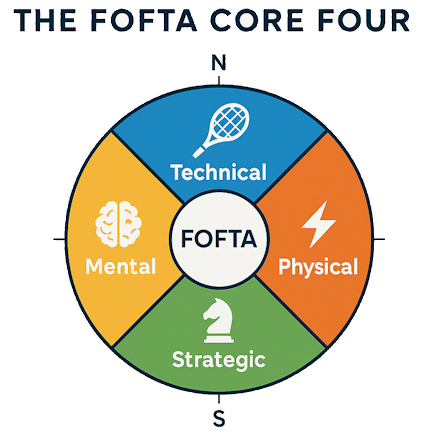
The Four Pillars of Complete Tennis Development
Understanding How Players Grow—One Stage at a Time
At FOFTA, we don’t just build tennis skills—we build tennis athletes. That means focusing on more than just hitting the ball. As your child develops, we train them through Four Pillars of Player Development:
- Technical
- Physical
- Strategic
- Mental
But here’s the key: not every pillar is emphasized equally at every age. A 6-year-old in Red Ball tennis isn’t being taught strategy or mindset tools the same way a 12-year-old in Green or Yellow Ball would be. Our coaching follows the ROGY system (Red, Orange, Green, Yellow), which introduces skills in age-appropriate, stage-appropriate progressions.
Let’s walk through the four pillars and show how they evolve with your child’s journey.

🛠️ 1. Technical – Learning How to Hit the Ball
This is the first and most important pillar, especially in Red and Orange Ball tennis.
Technical development involves stroke mechanics: how to hit a forehand, backhand, volley, serve, and overhead. In the early years, technique is taught through fun, simple games that build muscle memory and confidence.
What this looks like by stage:
- Red Ball: Hand-eye coordination, simple swings, learning to rally
- Orange Ball: Stroke shaping, consistency, and footwork around the ball
- Green Ball: More advanced grips, spin development, serve mechanics
- Yellow Ball: Refining full-stroke mechanics under pressure
📌 Parent Tip: Don’t worry if it doesn’t look “perfect” early on—focus on progress, not perfection.
💪 2. Physical – Becoming a Better Mover
Even young players need to move well to succeed. Physical development is about building the athletic foundation that supports every tennis skill.
This includes:
- Balance and coordination
- Speed and agility
- Reaction time
- Strength and stability (age-appropriate)
What this looks like by stage:
- Red Ball: Obstacle courses, footwork games, skipping, jumping, and throwing
- Orange Ball: Ladders, cones, movement to and from the ball
- Green Ball: Core work, dynamic warm-ups, speed drills
- Yellow Ball: Conditioning, strength training, recovery routines
📌 Parent Tip: Movement is a skill. Even kids who seem “unathletic” at first can develop excellent footwork with time.
🧠 3. Strategic – Learning How to Play Smart
This pillar becomes more important as players mature and can sustain rallies. Strategy involves learning where to hit, when to hit it, and why. It builds decision-making and court awareness.
What this looks like by stage:
- Red Ball: Mostly absent—focus is on rallying and fun
- Orange Ball: Basic concepts like cross-court vs down-the-line, using space
- Green Ball: Point construction, shot patterns, exploiting strengths
- Yellow Ball: Advanced tactics, opponent analysis, game plans
📌 Parent Tip: Early on, don’t worry if your child “just hits it back.” Strategy is a higher-level skill that comes with time and consistency.
🧠 4. Mental – Staying Confident and Focused
Tennis can be emotional—even for kids. Mental development helps players learn how to stay positive, focused, and resilient. This pillar becomes more intentional as your child progresses through the ROGY stages.
What this looks like by stage:
- Red Ball: Fun, low-pressure environment to build enjoyment
- Orange Ball: Encouragement, dealing with mistakes, trying again
- Green Ball: Building focus, routines between points, managing frustration
- Yellow Ball: Visualization, self-talk, mental resets, handling competition nerves
📌 Parent Tip: Your voice matters. Praise your child’s effort, not just results. Help them see failure as a stepping stone, not a stop sign.
